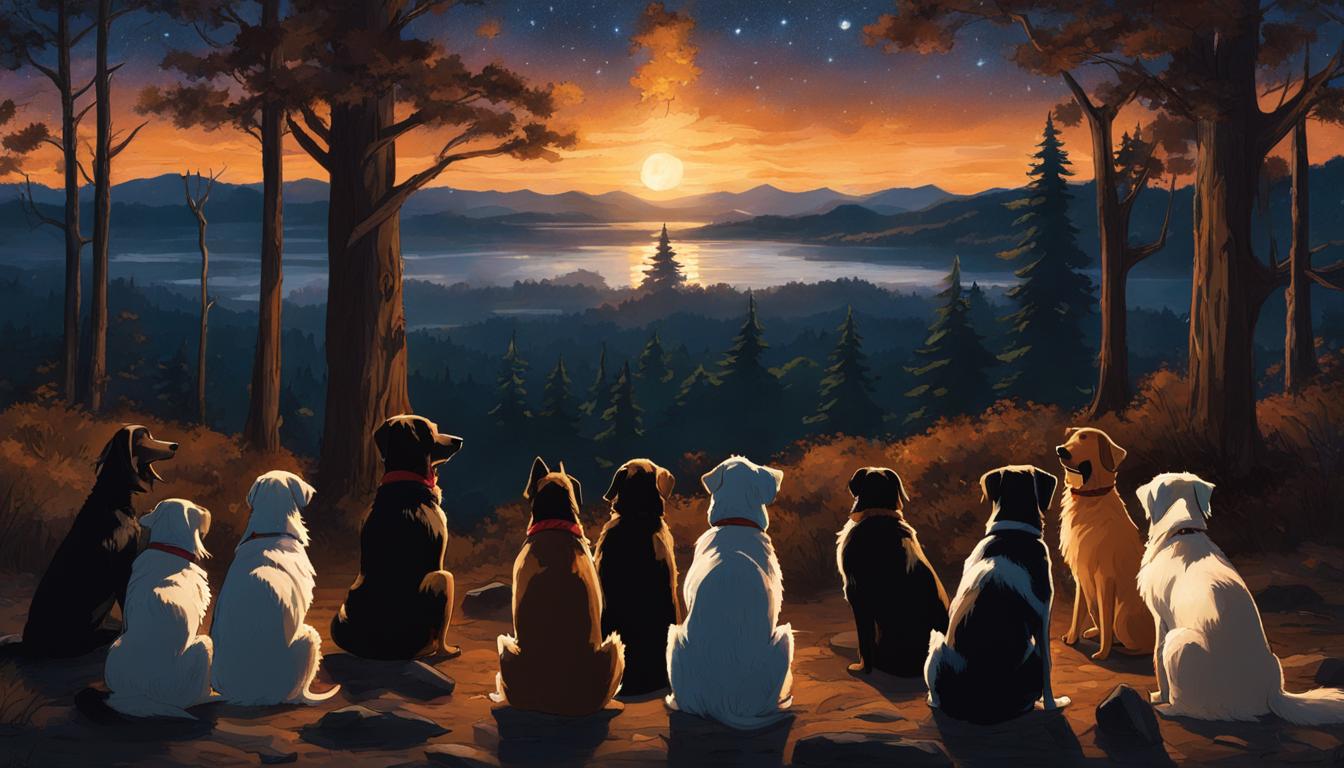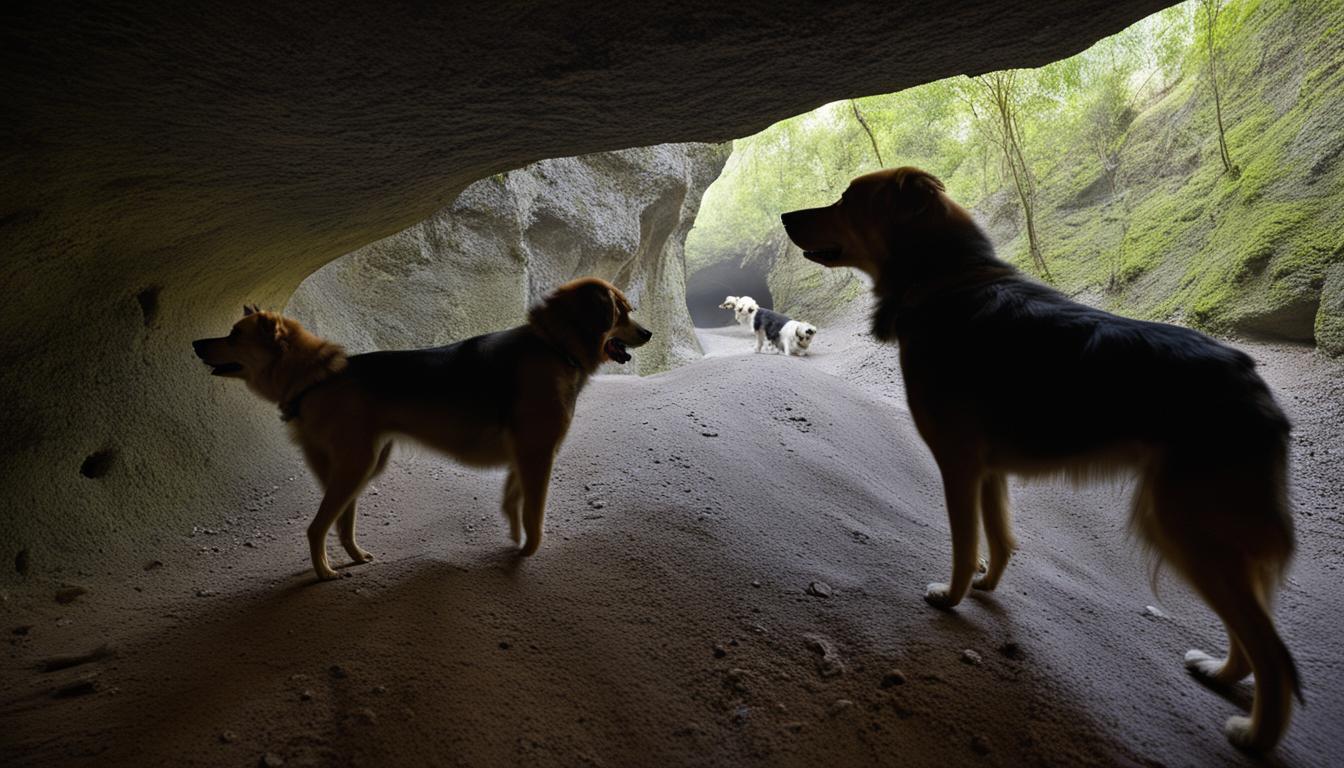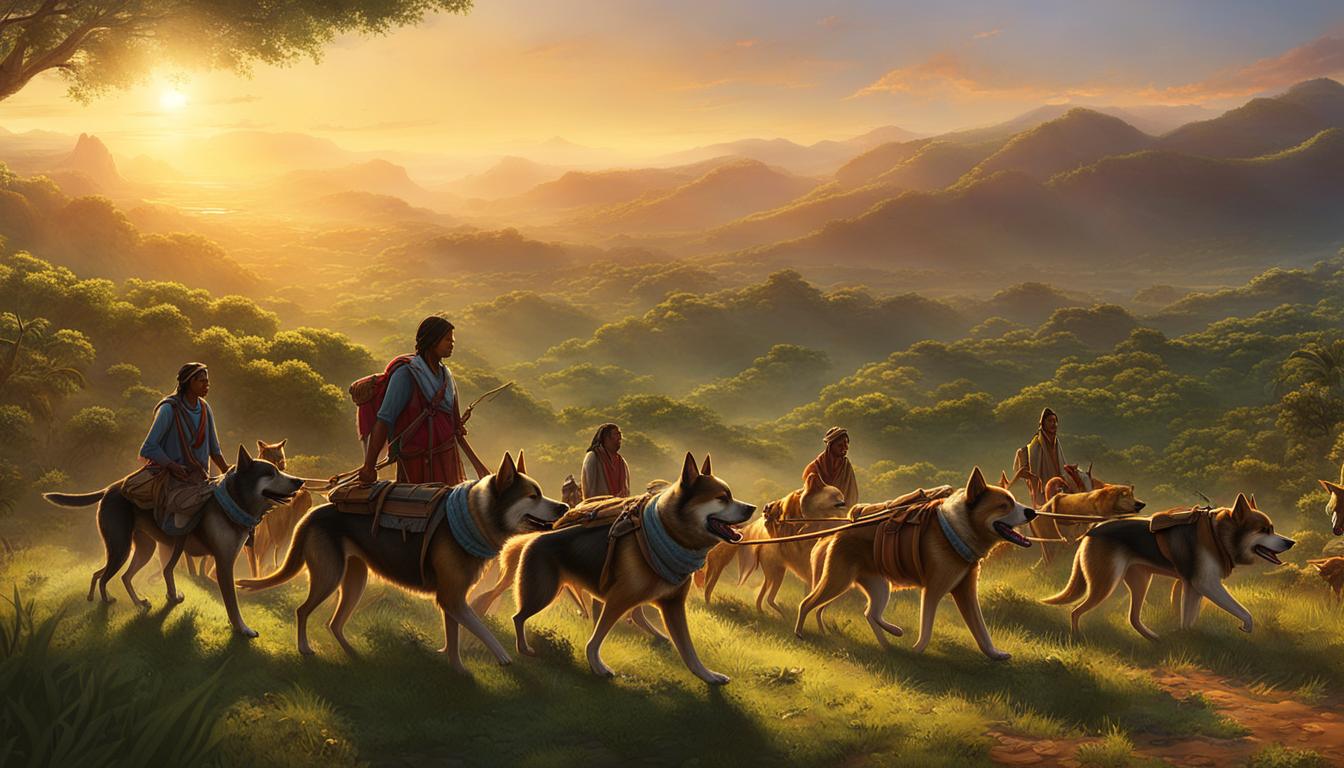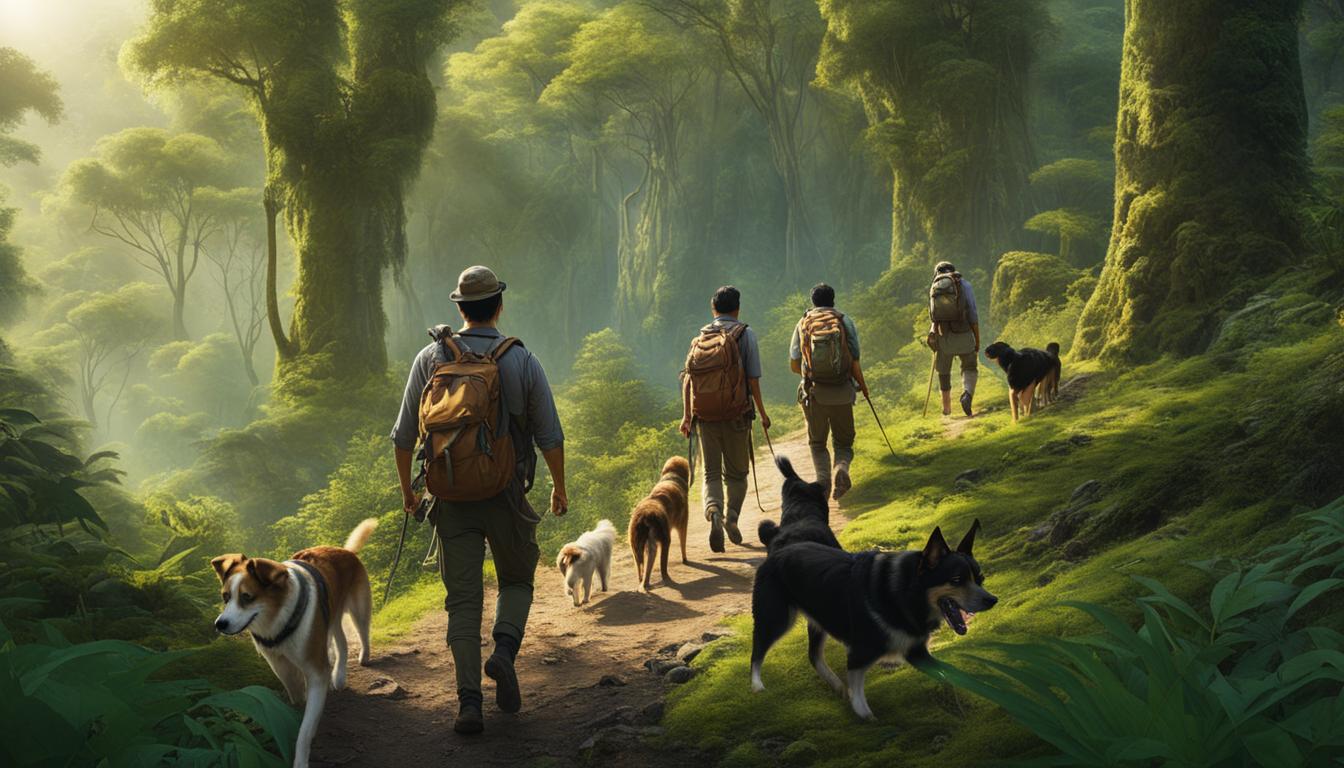Welcome to the enchanting world of canine folklore! Throughout history, dogs have captivated our hearts and minds, becoming the stars of countless tales and legends. From ancient civilizations to modern cultures, the stories of these loyal companions have weaved their way into our cultural tapestry.
In this article, we will explore the fascinating realm of folklore dog tales. Discover the diverse roles that dogs play in different cultures, from being seen as protectors and guides to serving as omens of death. These stories offer profound insights into the beliefs and values of societies, showcasing the deep bond between humans and canines.
Key Takeaways:
- Canine folklore is prevalent in cultures around the world.
- Dogs symbolize loyalty, protection, and companionship in folklore.
- Black dogs feature prominently in English and European folklore, often associated with the supernatural.
- Celtic lore portrays dogs as heroic companions, highlighting the importance of relationships.
- In Mesoamerican mythology, dogs hold spiritual significance as guardians and guides.
Embark on this journey through the captivating world of folklore dog tales and discover the stories that have shaped our cultural heritage.
Dogs in English Folklore
Dogs have been a recurring theme in folklore and mythologies across the world, playing various roles that provide insights into different cultures’ beliefs and values. In English folklore, black dogs feature prominently, often associated with death and the supernatural. However, not all black dogs are seen as menacing creatures. Some, like the Gurt Dog of Somerset, are revered as guardian dogs who protect travelers from harm.
These tales of black dogs in English folklore highlight the diversity of dog stories in different regions and among different storytellers. While some stories depict black dogs as harbingers of doom, others portray them as loyal companions and protectors. The significance of black dogs in folklore also extends to specific breeds, such as the Pembroke Welsh Corgi, which is believed to possess magical powers in Welsh tales.
“The Gurt Dog is a massive black dog that appears at crossroads and other haunted places. He’s supposed to be an omen of death, but a lot of folks think he’s a guardian spirit that looks after travelers. When you see him, you better make the right choices because he can be testy if you don’t.”
The Gurt Dog of Somerset
The Gurt Dog is a mythical creature that haunts the crossroads and other haunted locations in Somerset, England. While some consider it an omen of death, others see it as a protective spirit watching over travelers. The Gurt Dog is known to be testy if people do not make the right choices upon encountering it. This folklore surrounding the Gurt Dog emphasizes the importance of making wise decisions and staying on the right path.
| Role | Appearance | Special Abilities |
|---|---|---|
| Guardian | Large black dog | Protects travelers |
| Omen | Symbol of death | Foretells doom |
| Testy spirit | Quick to anger | Requires right choices |
These tales of black dogs in English folklore provide a fascinating glimpse into the cultural beliefs and superstitions of the past. Whether seen as protectors or omens, black dogs have left an indelible mark on traditional tales and continue to captivate our imagination today.
Dogs in Celtic Lore
Celtic folklore is filled with enchanting tales of dogs, portraying them as loyal and heroic companions. These mythical dogs hold a special place in the hearts of the Celts, symbolizing loyalty and the importance of relationships. One of the most beloved stories from Welsh folklore is the legend of Gelert, a faithful hound who met a tragic end at the hands of his own master. This tale serves as a cautionary reminder against impulsive actions and the weight of living with regret.
“In the land of the Celts, dogs are revered for their unwavering loyalty and their ability to guide us through the darkest of times. They are our trusted companions, protecting us from harm and offering solace in times of need.”
Dogs in Celtic lore are often depicted as protectors and guides, accompanying heroes on their quests and offering invaluable support. Their stories showcase the power of faithfulness and the deep bond between humans and canines. Whether they are assisting in battles, leading lost souls to the afterlife, or embodying the spirit of legendary warriors, these dogs play significant roles in Celtic culture and mythology.
Explore the rich tapestry of Celtic folklore and immerse yourself in the enchanting world of dogs as heroic companions and guardians. Their stories will transport you to a realm where loyalty is celebrated and where dogs hold a revered place in the hearts of the Celts. Discover the enduring legacy of these mythical dogs as they continue to inspire and captivate us with their courage and unwavering loyalty.
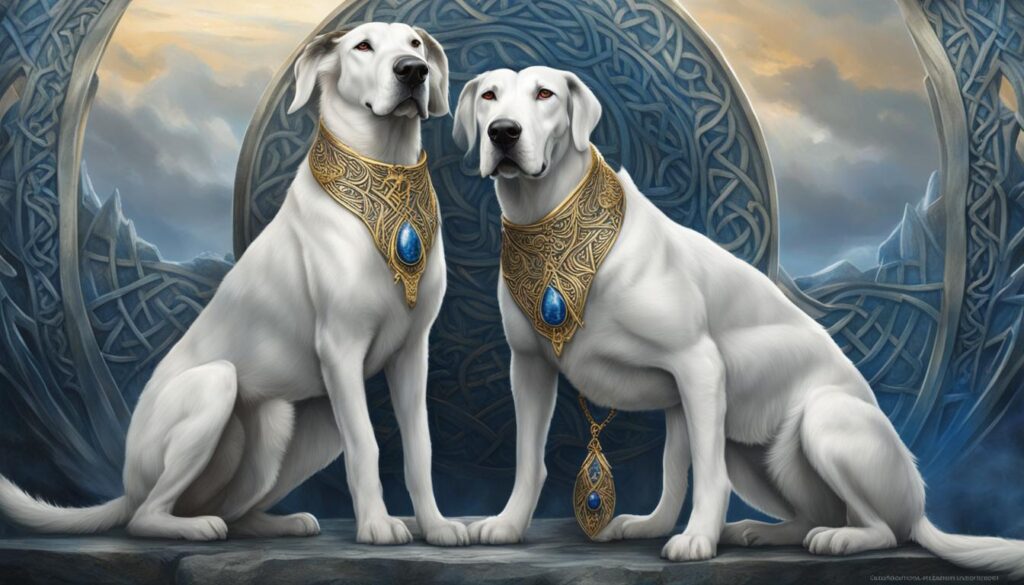
Dogs in Mesoamerican Mythology
In Mesoamerican mythology and folklore, dogs hold a significant place and are revered for their spiritual significance. They are believed to guide the souls of the dead in the afterlife, ensuring their safe passage. One prominent figure is the Xoloitzcuintli, a hairless dog breed, which is considered a guardian and protector in Mesoamerican cultures. This breed is believed to safeguard homes from evil spirits and is often associated with rituals and ceremonies.
The Xoloitzcuintli’s association with rituals and ceremonies can be seen in various Mesoamerican civilizations, such as the Aztecs and Mayans. These cultures believed that the Xoloitzcuintli had a special connection with the gods and played a role in religious ceremonies. The dogs were often depicted in artwork and were sometimes sacrificed and buried alongside their owners to accompany them in the afterlife.
In Aztec mythology, the god Xolotl is closely associated with dogs. Xolotl is the god of death and the underworld and is often depicted with a dog-like appearance. He is believed to guide the souls of the deceased and protect them on their journey to the afterlife. Xolotl’s connection to dogs reinforces the spiritual significance of these animals in Mesoamerican culture.
| Mythological Figure | Role | Symbolism |
|---|---|---|
| Xoloitzcuintli | Guardian and protector | Protection from evil spirits |
| Xolotl | God of death and the underworld | Guide souls to the afterlife |
The stories and beliefs surrounding dogs in Mesoamerican mythology reflect the importance of these animals in the culture’s spiritual and religious practices. They serve as protectors and guides, ensuring the well-being of both the living and the deceased. Dogs are deeply intertwined with the Mesoamerican worldview, representing loyalty, companionship, and the connection between humans and the divine.
Dogs in European Folklore
Dogs hold a significant place in European folklore, with stories featuring black dogs that are steeped in mystery and the supernatural. These enigmatic creatures are often portrayed as omens of doom, crossing paths with unsuspecting travelers at ancient crossroads and places of execution. They evoke a sense of unease, serving as reminders of our mortality and the unknown forces that surround us.
Black dogs in European folklore are not limited to a single country; they appear in tales from England, Jersey, and France, among others. Each region has its own unique story, intertwining themes of death, the afterlife, and the supernatural. These accounts shed light on the deep-rooted fears and fascination humans have with the mysterious and the beyond.
In English folklore, the Black Shuck is a prominent example of a black dog associated with the supernatural. This legendary creature, said to roam the countryside, is believed to be a harbinger of death. Its appearance is often described as large and hound-like, with fiery eyes and shaggy black fur. The Black Shuck’s presence is said to bring misfortune and tragedy, instilling fear in those who encounter it.
The enduring presence of black dogs in European folklore serves as a testament to the power of storytelling and the human imagination. These tales capture our deepest fears and desires, as well as our curiosity about the unknown. Whether they are omens of death or guardians of ancient pathways, black dogs continue to intrigue and captivate us with their supernatural allure.
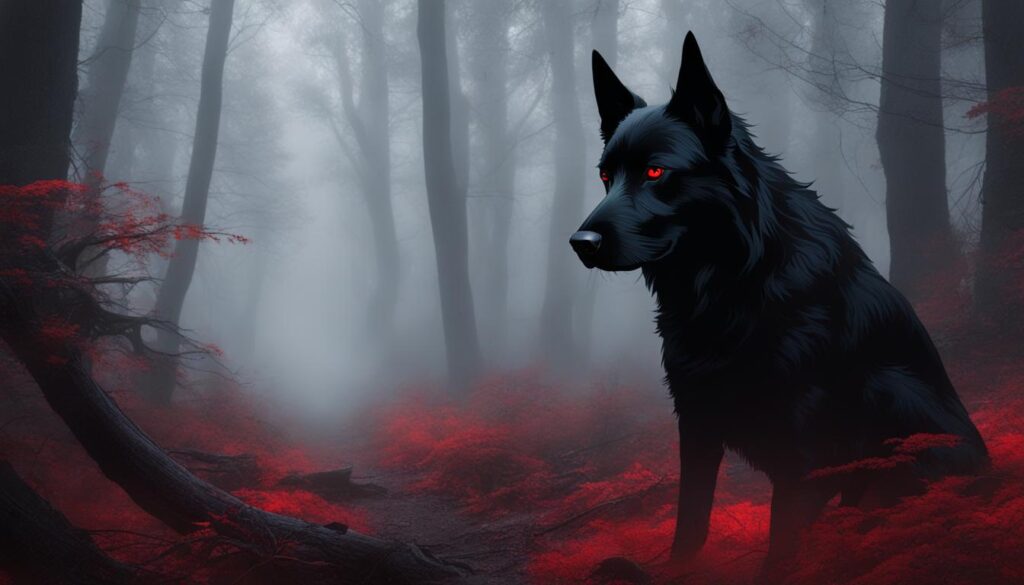
| Country | Black Dog Folklore |
|---|---|
| England | The Black Shuck – A harbinger of death, roaming the countryside |
| Jersey | The Black Dog of Bouley Bay – Associated with the paranormal and ghostly apparitions |
| France | The Black Dog of Bungay – Known for its apparitions in thunderstorms and churchyards |
Conclusion
As we conclude our exploration of folklore dog tales, we are reminded of the timeless connection between humans and canines. Dogs have been woven into the fabric of cultures around the world, playing various roles and embodying different beliefs and values.
From black dogs in English folklore to legendary dogs in Celtic lore, these stories offer us glimpses into the diverse cultural tapestry of our world. Through these tales, we learn lessons of loyalty, faithfulness, and the power of relationships.
Whether dogs are depicted as protectors, guides, or harbingers of doom, their influence on folklore is undeniable. They captivate our imagination and leave a lasting impression on our collective consciousness.
So, the next time you encounter a dog tale, remember the rich history and depth of meaning behind it. Dogs in folklore are not merely characters; they are symbolic representations of our shared experiences and the enduring bond between humans and our faithful companions.
FAQ
What role do dogs play in folklore and mythologies around the world?
Dogs are often celebrated for their loyalty and companionship in folklore and mythologies. They can be seen as protectors, guides, or omens of death, depending on the cultural context.
How are black dogs portrayed in English folklore?
In English folklore, black dogs are often associated with death and the supernatural. However, some black dogs, like the Gurt Dog of Somerset, are considered guardian dogs who protect travelers from harm.
What is the significance of dogs in Celtic folklore?
In Celtic folklore, dogs symbolize loyalty and the importance of relationships. They are often depicted as protectors and guides, showcasing the power of faithfulness.
How do dogs feature in Mesoamerican mythology and folklore?
Dogs hold a significant place in Mesoamerican mythology and folklore. They are believed to guide the souls of the dead in the afterlife and are considered guardians and protectors.
What role do black dogs play in European folklore?
Black dogs appear in European folklore, often associated with death and the supernatural. They are believed to be omens of doom and are associated with crossroads and ancient pathways.
What do dogs in folklore tell us about cultural beliefs and values?
Dogs in folklore provide insights into cultural beliefs, values, and the deep connection between humans and canines. They are an enduring fascination and part of our cultural tapestry.

